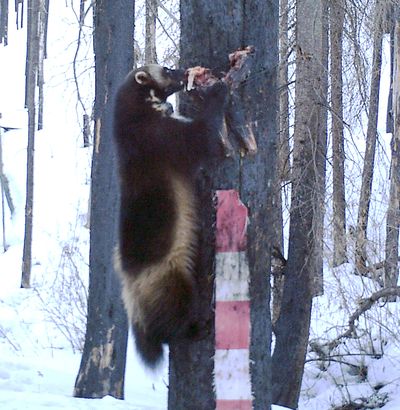Post-forest fire study finds seldom-seen carnivores

DARBY, Mont. – There was no way of knowing what kind of critters might venture through the charred trees left last year in the wake of a wildfire in Soldier Creek.
“The ground was basically dust,” said Bitterroot National Forest biologist Andrea Shortsleeve.
Far up in the head of the West Fork drainage not far from Devil Creek, a team of Bitterroot National Forest researchers led by the biologist decided to set a photographic trap in an effort to see what might show up.
So they tied a leg taken from road-killed deer high up on a blackened tree with a stout piece of wire. And then they carefully placed a series of stiff wire brushes into the bark of the tree to capture some fur from passing carnivores.
After that was done, they attached a trail camera to a nearby tree with its lens pointed at the bait.
And just to make sure that a passing critter would know that a free meal was waiting, they hung two sponges pasted with a smelly concoction called Craven’s Gusto onto a couple of nearby branches.
Shortsleeve said no one knew just what to expect.
Not long after the photographic trap was set, the researchers were excited to see a series of images of an elusive wolverine clinging to the tree while it snacked on the red meat.
“That surprised me,” Shortsleeve said. “We didn’t expect a wolverine to show up in an area that had been completely burned.”
Last year was the first for a new forest carnivore study on the Bitterroot National Forest that hopes to unlock some secrets about the elusive three: wolverine, fisher and Canada lynx.
Shortsleeve took the lead in putting together the study after hearing about a similar effort in Idaho while attending a wildlife conference.
Last year, the small research team started with 10 trail cameras, which they used to record the scene at 33 different stations through the winter in the wilderness along the Selway corridor.
By the time the winter was over, they had more than 10,000 pictures to look through.
“Some of them were pictures of moss moving in the breeze or snow falling, but those were easy to flip through,” she said. “We also had a chance to see a lot of photos of secretive critters.
“It’s rare for anyone to see a wolverine or a fisher in the wilds,” Shortsleeve said. “We had a chance to see them in action in a series of photos.”
The researchers also collected 250 samples of fur from the gun barrel brushes attached to the tree and sent those off for DNA analysis.
“We are still waiting to get some of the analysis back,” Shortsleeve said. “We know we have four wolverines, three fishers and a ton of marten, bobcat and weasel hits.”
There were not any sightings of lynx.
“The last verified lynx sighting in the Bitterroot was 30 years ago,” she said. “People have seen tracks, which have been verified, in the early 1990s, but the last time an animal was actually seen was in 1983.”
This year, the research crew is expanding its range to drainages further east along the West Fork of the Bitterroot River. They now have 30 trail cameras that will gather information all winter long.
They’ve already had a few great sightings.
“I heard we had some recent photos of a martin that got its tail stuck in one of the brushes,” she said. “It spent about 10 minutes trying to get free. It apparently seemed a little annoyed.
“It does show you how unique the Bitterroot and Sapphire mountains are,” Shortsleeve said. “We live in an amazing area with really unique and interesting critters. We should do everything we can to learn more about them.”
Bitterroot Forest Wildlife Staff Officer Gil Gale hopes eventually the information gleaned from the study will help Bitterroot National Forest officials make better informed decisions on how to manage habitat.
With the wolverine apparently headed for listing as a threatened species, Gale said, any additional detailed and accurate information will be particularly important.
Researchers estimate that there are a total of about 250 wolverines in the entire Northern Rockies.
There’s no way of knowing how many call the Bitterroot home.
“They are one of the rarest mammals in the lower 48 states,” Gale said. “We don’t have an estimate of how many there are on the Bitterroot Forest. It’s a very good question and one we’re trying to answer, in part, through this research.
“It’s low cost and nothing fancy, but it will generate some useful data,” Gale said.
The public can help.
Gale said it would be helpful to hear from people who spot a wolverine or fisher in the wilds. They can make those reports to Shortsleeve at the West Fork Ranger District or Dave Lockman at the Stevensville district.
“The more eyes on the ground the better,” Gale said. “It would really help us prioritize the areas we want to focus on.”